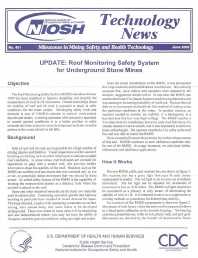Mining Publication: Technology News 481 - Update: Roof Monitoring Safety System for Underground Stone Mines
Original creation date: June 2000
The Roof Monitoring Safety System (RMSS) introduced in late 1997 has been modified to improve durability and simplify the measurement of roof or rib movement. Greater knowledge about the stability of roof and rib rock is expected to result in safer condition for the mine worker. Developing safety tools land methods is part of NIOSH's mission to prevent work -related injuries and deaths. A mining operation with a proactive approach to control ground conditions is in a better position to made essential decisions related to mine development and take remedial action in the event of roof or rib falls. Falls of roof and rib rock are responsible for a high number of mining injuries and fatalities. Visual inspections and the sound of breaking or cracking rock are often relied upon to indicate unstable roof conditions. In some mines, roof bolt holes are checked for separations or gaps with a scratch tool; this provides further information about the stability of the roof. Monitors such as the RMSS can confirm roof movement that was surmised only by eye or ear, or potentially detect movement that was missed by these means. An added safety feature of the RMSS is the capability of locating the measurement station at a distance from where the monitor is placed in the roof. Stone and other industrial minerals are the basic raw materials used in construction. Continuing economic growth and highway building in particular have resulted in record demand for stone. This high demand, coupled with increasing constraints on surface mining, have caused many new stone mines to be developed underground. These new mines in many cases will be employing new and inexperienced miners who may not have the ability to recognize unstable ground conditions using just sight and sound.
Authors: National Institute for Occupational Safety and Health
Technology News - June 2000
NIOSHTIC2 Number: 20000480
Pittsburgh, PA: U.S. Department of Health and Human Services, Public Health Service, Centers for Disease Control and Prevention, National Institute for Occupational Safety and Health, Technology News 481, 2000 Jun; :1-2
See Also
- A Computer Software Program that Estimates Air Quantity Requirements in Large Opening Stone Mines
- Effects of Weak Bands on Pillar Stability in Stone Mines: Field Observations and Numerical Model Assessment
- Field Observations and Numerical Studies of Horizontal Stress Effects on Roof Stability in U.S. Limestone Mines
- Field Observations and Numerical Studies of Horizontal Stress Effects on Roof Stability in U.S. Limestone Mines
- New Developments with the Coal Mine Roof Rating
- Roof Monitoring Helps Prevent Injuries in Stone Mines
- Roof Monitoring in Limestone - Experience with the Roof Monitoring Safety System (RMSS)
- A Roof Quality Index for Stone Mines Using Borescope Logging
- Roof Span Design for Underground Stone Mines
- Roof Stability Issues in Underground Limestone Mines in the United States
- Content source: National Institute for Occupational Safety and Health, Mining Program


 ShareCompartir
ShareCompartir
